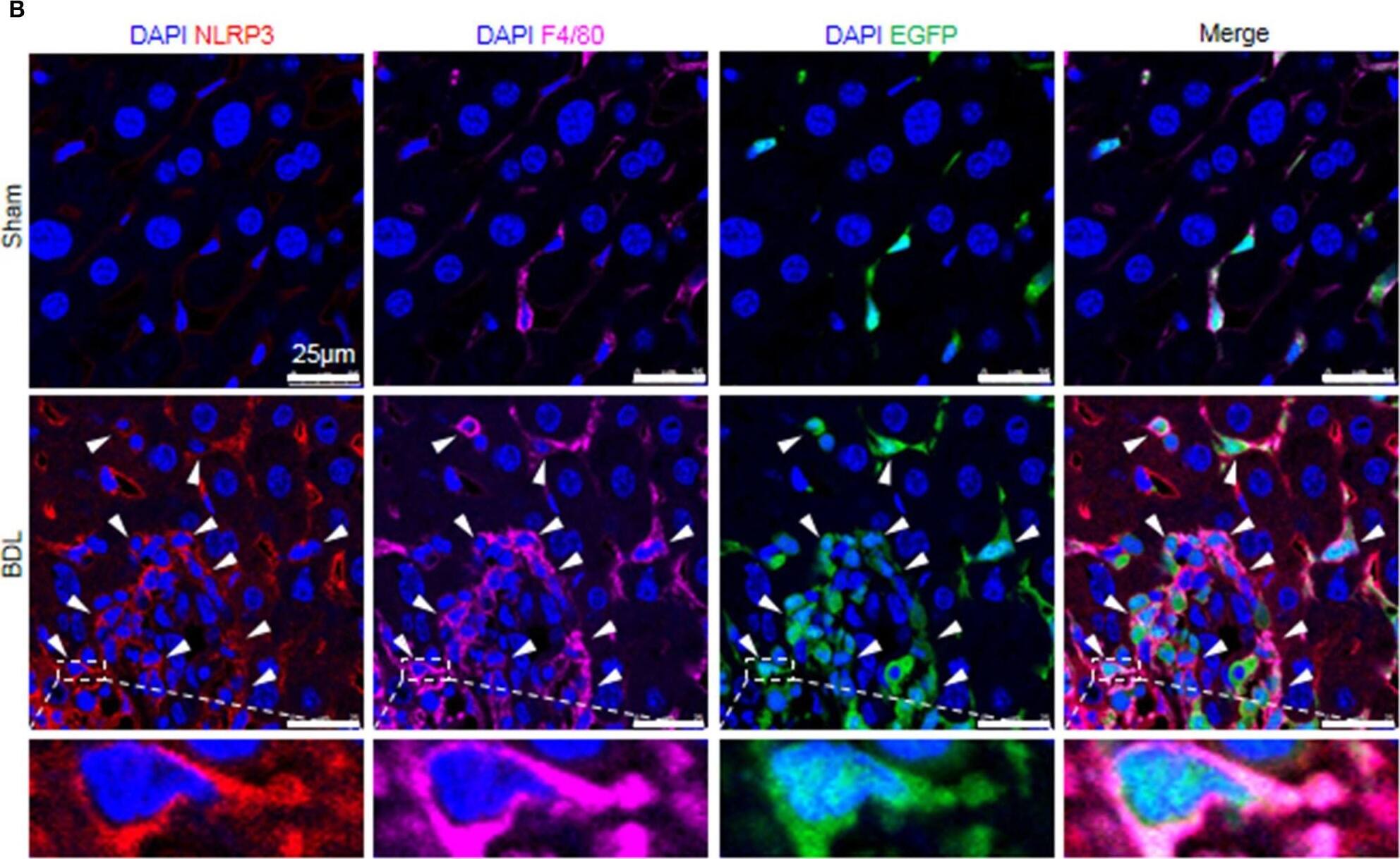Human/Mouse NLRP3/NALP3 Alexa Fluor® 750-conjugated Antibody
R&D Systems, part of Bio-Techne | Catalog # IC7578S


Key Product Details
Validated by
Species Reactivity
Applications
Label
Antibody Source
Product Specifications
Immunogen
Met1-Arg153
Accession # Q8R4B8
Specificity
Clonality
Host
Isotype
Scientific Data Images for Human/Mouse NLRP3/NALP3 Alexa Fluor® 750-conjugated Antibody
Detection of Mouse NLRP3/NALP3 by Flow Cytometry
The cell-specific expression pattern of NLRP3 in the fibrotic liver of BDL-treated mice. (A) Mice were anesthetized and sacrificed at 2 weeks after sham or BDL operation. NLRP3 positive cells of the mouse liver non-parenchymal cells were analyzed for T cells, endothelial cells, dendritic cells, and macrophages-specific markers (CD3e, CD31, CD11c, and F4/80, respectively). Mice were lethally irradiated and received whole bone marrow cell transplants from EGFP transgenic mice, followed by sham or BDL operation. At 2 weeks after sham or BDL operation, the proportion of NLRP3+ cells in BMMs (F4/80+ EGFP+) was analyzed by FACS. (B) Representative images of immunofluorescence analysis by confocal microscopy to track the expression of NLRP3 (red) in macrophages (F4/80+, pink) of bone marrow origin (EGFP+, green) in mouse liver tissue. Data are presented as the mean ± SEM. n = 6 per group. Student's t-test was used in panel (A). *p < 0.05 vs. sham group. Image collected and cropped by CiteAb from the following publication (https://pubmed.ncbi.nlm.nih.gov/32695095), licensed under a CC-BY license. Not internally tested by R&D Systems.Detection of Mouse NLRP3/NALP3 by Flow Cytometry
The cell-specific expression pattern of NLRP3 in the fibrotic liver of BDL-treated mice. (A) Mice were anesthetized and sacrificed at 2 weeks after sham or BDL operation. NLRP3 positive cells of the mouse liver non-parenchymal cells were analyzed for T cells, endothelial cells, dendritic cells, and macrophages-specific markers (CD3e, CD31, CD11c, and F4/80, respectively). Mice were lethally irradiated and received whole bone marrow cell transplants from EGFP transgenic mice, followed by sham or BDL operation. At 2 weeks after sham or BDL operation, the proportion of NLRP3+ cells in BMMs (F4/80+ EGFP+) was analyzed by FACS. (B) Representative images of immunofluorescence analysis by confocal microscopy to track the expression of NLRP3 (red) in macrophages (F4/80+, pink) of bone marrow origin (EGFP+, green) in mouse liver tissue. Data are presented as the mean ± SEM. n = 6 per group. Student's t-test was used in panel (A). *p < 0.05 vs. sham group. Image collected and cropped by CiteAb from the following publication (https://pubmed.ncbi.nlm.nih.gov/32695095), licensed under a CC-BY license. Not internally tested by R&D Systems.Applications for Human/Mouse NLRP3/NALP3 Alexa Fluor® 750-conjugated Antibody
Intracellular Staining by Flow Cytometry
Sample: RAW 264.7 mouse monocyte/macrophage cell line and human peripheral blood monocytes fixed with paraformaldehyde and permeabilized with saponin
Formulation, Preparation, and Storage
Purification
Formulation
Shipping
Stability & Storage
Background: NLRP3/NALP3
Long Name
Alternate Names
Gene Symbol
UniProt
Additional NLRP3/NALP3 Products
Product Documents for Human/Mouse NLRP3/NALP3 Alexa Fluor® 750-conjugated Antibody
Product Specific Notices for Human/Mouse NLRP3/NALP3 Alexa Fluor® 750-conjugated Antibody
This product is provided under an agreement between Life Technologies Corporation and R&D Systems, Inc, and the manufacture, use, sale or import of this product is subject to one or more US patents and corresponding non-US equivalents, owned by Life Technologies Corporation and its affiliates. The purchase of this product conveys to the buyer the non-transferable right to use the purchased amount of the product and components of the product only in research conducted by the buyer (whether the buyer is an academic or for-profit entity). The sale of this product is expressly conditioned on the buyer not using the product or its components (1) in manufacturing; (2) to provide a service, information, or data to an unaffiliated third party for payment; (3) for therapeutic, diagnostic or prophylactic purposes; (4) to resell, sell, or otherwise transfer this product or its components to any third party, or for any other commercial purpose. Life Technologies Corporation will not assert a claim against the buyer of the infringement of the above patents based on the manufacture, use or sale of a commercial product developed in research by the buyer in which this product or its components was employed, provided that neither this product nor any of its components was used in the manufacture of such product. For information on purchasing a license to this product for purposes other than research, contact Life Technologies Corporation, Cell Analysis Business Unit, Business Development, 29851 Willow Creek Road, Eugene, OR 97402, Tel: (541) 465-8300. Fax: (541) 335-0354.
For research use only
